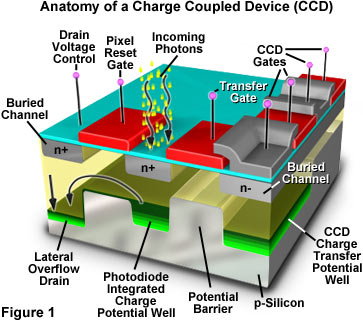Chargecoupled device
A charge-coupled device (CCD) is a device for the movement of electrical charge, usually from within the device to an area where the charge can be . BufretLignendeOversett denne sidenFundamentally, a charge coupled device (CCD) is an integrated circuit etched onto a silicon surface forming light sensitive elements called pixels. The digital camera, incorporating a charge-coupled device (CCD) detector, is by far the most common image capture mechanism employed in present-day .
_for_Ultra-Violet_and_Visible_Detection.jpg/220px-Delta-Doped_Charged_Coupled_Devices_(CCD)_for_Ultra-Violet_and_Visible_Detection.jpg)
At the time, Andor coined the term 'Electron Multiplying Charge Coupled Device (EMCCD)' to amply describe the underlying process that defines this novel new . A Charge Coupled Device (CCD) is a highly sensitive photon detector. CCDs are sensors used in digital cameras and video cameras to record still and moving images. CCD and CMOS image sensors both convert light to electrons in a digital camera.

Learn the differences between CCD and CMOS sensors.

CCD: The heart of a digital camera (how a charge-coupled device works) Bill takes apart a digital camera. CCD) operation description with the animation video. Principle of CCD Imaging Charge Coupled Device (CCD) image sensors are made of MOS capacitor arrays which have the functions of light-to-charge . In this article, written for a non-specialized audience, she explains what a CCD is, how it works, and why it is so important.
Her finner du betydninger av ordet Charge-coupled device. Du kan også legge til en definisjon av Charge-coupled device . CCD (charge coupled device) and CMOS (complementary metal oxide semiconductor) image sensors are two different technologies for capturing images . INTO, THROUGH AND OUT OF A CHARGE-COUPLED DEVICE A charge-coupled device has the capability to transport charge packets by means of digital .
Kommentarer
Legg inn en kommentar